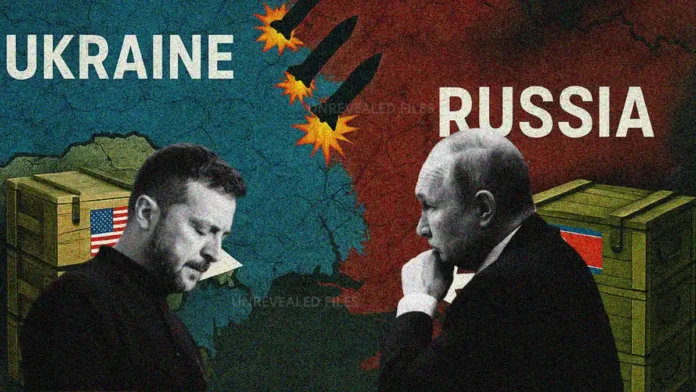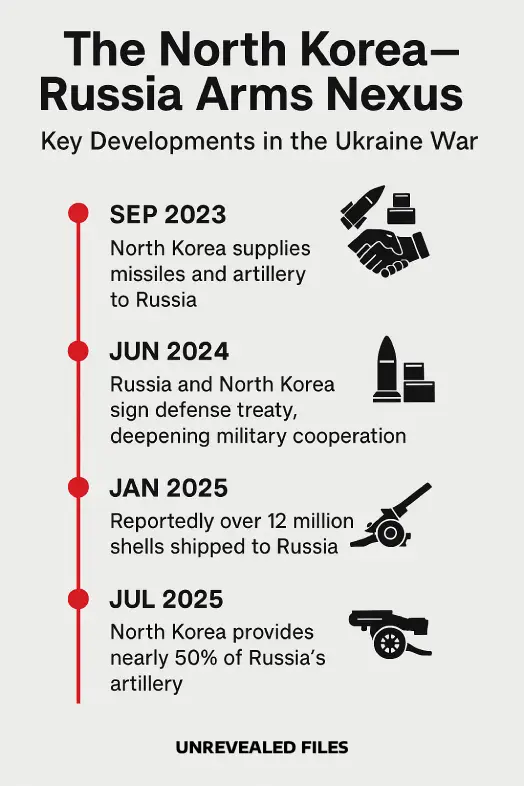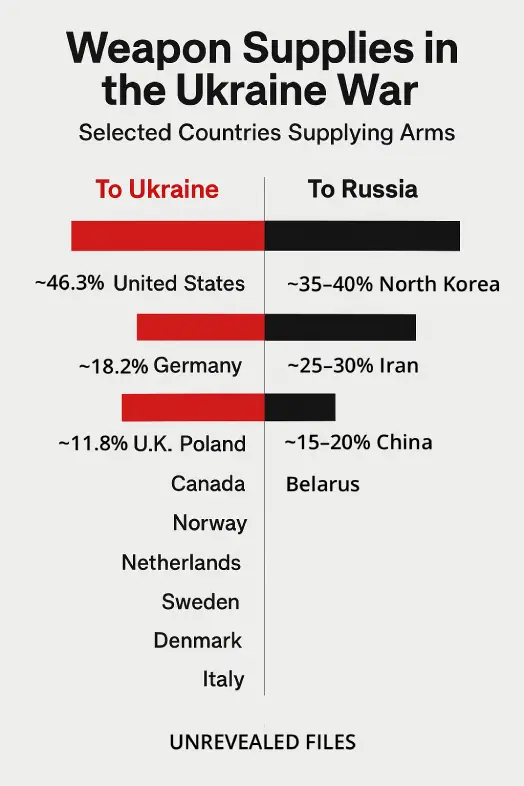
In an era of geopolitical double standards, the world watches with alarm as North Korea expands its support for Russia in the ongoing Ukraine conflict. Western media and governments have condemned this partnership as a threat to global security, but their outrage rings hollow. Why? Because these same critics are active participants in a sprawling proxy war, arming, funding, and guiding Ukraine’s military in a conflict that is far from one-sided.
Recent reports reveal North Korea now supplies up to 40% of Russia’s artillery ammunition for the Ukraine war, triggering widespread condemnation in Western media. However, a broader examination shows a more complex, morally ambiguous situation, one where virtually every major global power actively participates in escalating a conflict that has already claimed hundreds of thousands of lives.
Is it fair to single out North Korea for condemnation? Or does this arms partnership merely reflect the reality of a globalized proxy war, where both sides receive weapons, funding, and support from foreign allies?
Contents
North Korea Arms Russia
North Korea’s delivery of artillery shells and missiles to Russia was first reported in 2023 when Kim Jong Un visited Russia’s Vostochny Cosmodrome and met with President Vladimir Putin. With traditional supply lines disrupted and global sanctions squeezing its military-industrial complex, Russia turned to Pyongyang for its most urgent needs: artillery, missiles, and drones. In return, North Korea saw an opportunity to exchange its vast stockpile of munitions for fuel, food, and access to advanced military and satellite technology.

This covert partnership, rapidly escalating into 2024 and 2025, has sparked outrage in Washington, Brussels, and Seoul. Yet this condemnation ignores the elephant in the room: NATO and Western countries have been supplying Ukraine with advanced weaponry, intelligence, and billions in military aid since 2022. The United States alone has provided over $46.3 billion in military assistance to Ukraine, while countries such as the UK, Germany, and Poland have followed suit with tanks, artillery, and air defense systems.
What North Korea Has Supplied
According to recent U.S. and South Korean intelligence reports, North Korea has delivered:
- Over 12 million artillery shells to Russia
- Tactical ballistic missiles, including KN-23 variants
- Military boots, uniforms, and food rations
- Possibly drone components and chemical materials used in explosives
What Russia Gives in Return
In exchange for arms, Russia provides North Korea with:
- Satellite launch and ballistic missile technology
- Fuel and refined petroleum
- Food aid amid internal shortages
- Support for infrastructure projects in border regions, such as rail and ports
New Developments (2025)
The story hasn’t faded; it has evolved dramatically:
- 40–52% of Russia’s artillery munitions are now sourced from North Korea, according to the Kyiv School of Economics and the U.S. Defense Intelligence Agency.
- North Korea has allegedly deployed 15,000–18,000 troops and workers to support Russia’s operations. Most are believed to be logistics personnel, labor battalions, and technical support crews, though hundreds may be involved near combat zones.
- In June 2024, North Korea and Russia signed the Treaty on Comprehensive Strategic Partnership, enabling mutual defense and military coordination, legally binding and officially in force since December 2024.
- North Korea is gaining satellite and air defense technologies, missile accuracy enhancements, and battlefield experience in return.
- Pyongyang’s arms factories are now operating at full capacity, expanding artillery and rocket production, and preparing for long-term military supply to Moscow.
- Russia has begun direct flights to Pyongyang via Nordwind Airlines, enabling potential logistics and tech exchange routes, possibly even circumventing traditional sanctions and tracking mechanisms.
Global Proxy Warfare
North Korea is not alone in supporting a war effort. On the other side, Ukraine has received over $100 billion in military aid from the United States, European Union, United Kingdom, Canada, and dozens of NATO allies.

These include:
- HIMARS rocket systems, Patriot air defenses, Leopard 2 tanks, and Storm Shadow missiles
- F-16 fighter jets, Bayraktar drones, and satellite-guided munitions
- Intelligence sharing, training, and cyber defense systems
Western condemnation of this partnership overlooks established precedent. If the U.S. and Europe can justify arming Ukraine as “defending democracy,” why is North Korea’s support for Russia viewed as uniquely dangerous? Shouldn’t both actions receive equal scrutiny? This selective moral outrage raises serious questions about consistency in international relations.
Ukraine relies heavily on external support rather than just domestic resources. NATO has provided extensive armaments along with real-time satellite intelligence and battlefield analytics from U.S. and European partners. This raises a logical question: if Ukraine can legitimately seek external support to resist invasion, shouldn’t Russia have the same right?
If we consider North Korea’s support of Russia as fueling the war, then Western aid to Ukraine logically serves the same function; a parallel that mainstream narratives frequently ignore.
The Proxy War We Refuse to Name
The condemnation of North Korea, while understandable from a diplomatic standpoint, reveals a troubling double standard. When the U.S. and NATO arm Ukraine, it is framed as defending democracy. When North Korea arms Russia, it is labeled a rogue act of aggression.
Yet both forms of support contribute to a longer, more devastating war. Both reduce incentives for diplomatic resolution. And both reflect a world order where smaller nations fight, while larger powers fuel the flames from a distance.
Sanctions and the Rise of Alternative Alliances
North Korea, Russia, and Iran, three of the most sanctioned nations in the world, are now forming an informal alliance of convenience. This group is actively circumventing traditional global norms and creating new logistical and military channels outside of U.S.-led institutions. Meanwhile, Western alliances like NATO are strengthening their supply chains and commitments to Ukraine, doubling down on a war with no clear end.
Techwar and the Global Shift
This conflict isn’t just about tanks and troops. It’s about algorithms, satellites, and drones. The North Korea–Russia arms nexus ties directly into a growing trend: the fusion of traditional military conflict with high technology and cyber warfare. Both sides are using the war in Ukraine as a proving ground for next-generation warfare.
Military Aid to Ukraine (2022–2025, Approx. Est. % – Subject to Change)
| Supplier Country | Estimated Share (%) | Nature of Support |
|---|---|---|
| United States | ~46.3% | HIMARS, Patriot systems, Javelins, tanks, artillery, ammo, drones, training |
| Germany | ~18.2% | Leopard tanks, IRIS-T systems, MARS II, vehicles, air defense systems, logistics |
| United Kingdom | ~7.8% | Storm Shadow missiles, Challenger 2 tanks, artillery, Sea King helicopters |
| Poland | ~4.3% | MiG-29 jets, tanks, howitzers, anti-air weapons, logistics |
| Netherlands | ~2.9% | F-16 training support, artillery shells, armored vehicles |
| Italy | ~1.2% | SAMP/T air defense systems, artillery, ammo |
| France | ~1.1% | Caesar howitzers, SCALP missiles, air defense and training |
| Sweden | ~2.1% | Archer artillery, armored vehicles, training, support systems |
| Others (Estonia, Latvia, Czechia, etc.) | ~16.1% | Caesar howitzers, SCALP missiles, air defense, and training |
Military Aid to Russia (2022–2025, Approx. Est. % – Subject to Change)
| Supplier Country | Estimated Share (%) | Nature of Support |
|---|---|---|
| North Korea | ~35–40% | Artillery shells, SPGs, ballistic missiles, MRLS |
| Iran | ~25–30% | Semiconductor components, machine tools, drone parts, and microelectronics |
| China (dual-use aid) | ~15–20% | Logistics support, launch bases, and limited coordinated arms transfers |
| Belarus | ~5–10% | Logistics support, launch bases, limited coordinated arms transfers |
| Others & Black Market | ~5% or less | Shahed drones, ballistic missiles, and drone production technology |
The situation reflects a larger truth: the Ukraine war is not just a matter of Ukraine versus Russia. It is NATO vs. Russia, and now North Korea vs. NATO by extension. The battlefield has become a testing ground for artillery accuracy, drone warfare, electronic jamming, and long-range missile coordination, strategic assets that both sides are using to refine their capabilities.
Instead of pretending to be shocked by North Korea’s involvement, global observers must acknowledge what the war has become: a proxy conflict drawing in ideologically opposed, militarily aggressive states, each using Ukraine as a crucible for next-generation warfare.
Conclusion
If we’re to condemn North Korea, then let us also scrutinize the global arms industry that sustains this war from both ends. Let us not pretend this is a one-sided violation of sovereignty or peace. Until global powers hold themselves to the same standard they impose on others, cries of outrage will continue to sound more like geopolitical theater than principled diplomacy.
In the age of strategic alliances and silent treaties, North Korea’s involvement is not an anomaly; it is the logical response to a world order where might defines right and alliances’ accountability.
To isolate North Korea as the villain in this arms race is to ignore the reality of our times. We live in a world where powerful nations do not merely influence wars; they prolong them. While North Korea may be feeding Russia’s guns, Western nations are filling Ukraine’s skies with jets and missiles.
This is not a simple story of good versus evil. It is a cautionary tale about a multipolar world drifting deeper into proxy warfare, where every bullet, bomb, and byte is part of a much larger, more dangerous game.
Also Read: While India Sleeps on a Nuclear Goldmine, China Leads the Thorium Revolution.
Sources
- Congressional Research Service. U.S. Security Assistance to Ukraine. Updated July 2024.
- Kiel Institute for the World Economy. Ukraine Support Tracker.
- European Council. EU Support to Ukraine. Council of the European Union, 2024.
- Ministry of Defence (UK). UK Military Support to Ukraine, 2024.
- International Institute for Strategic Studies (IISS). The Military Balance 2024. Routledge, 2024.
- Royal United Services Institute (RUSI). North Korea’s Munitions Support to Russia, 2024.
- Davenport, Kelsey. “US says North Korea shipped arms to Russia.” Arms Control Today 53.9 (2023): 30-31.
- 38 North. Tracking North Korea’s Arms Exports to Russia, 2023.
- Center for Strategic and International Studies (CSIS). Russia’s Military Supply Chains: Iran, China, and North Korea’s Role, 2023.
- Wikipedia contributors. Foreign Aid to Ukraine during the Russo-Ukrainian War, 2025.
- Carnegie Endowment for International Peace. Iran–Russia Drone Cooperation: Strategic Implications, 2023.
- Business Insider. North Korea Is Sending Russia Artillery Shells and Missiles, 2023.
- New York Post. North Korea Sends Ballistic Missiles to Russia, 2023.
- Kyiv Post. Russian Black Market Arms Channels Exposed, 2024.
FACT CHECK: We strive for accuracy and fairness. But if you see something that doesn’t look right, please Contact us.
DISCLOSURE: This Article may contain affiliate links and Sponsored ads, to know more please read our Privacy Policy.
Stay Updated: Follow our WhatsApp Channel and Telegram Channel.











